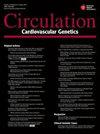Genetic Variation in the SLC8A1 Calcium Signaling Pathway Is Associated With Susceptibility to Kawasaki Disease and Coronary Artery Abnormalities
Q Medicine
引用次数: 41
Abstract
Background—Kawasaki disease (KD) is an acute pediatric vasculitis in which host genetics influence both susceptibility to KD and the formation of coronary artery aneurysms. Variants discovered by genome-wide association studies and linkage studies only partially explain the influence of genetics on KD susceptibility. Methods and Results—To search for additional functional genetic variation, we performed pathway and gene stability analysis on a genome-wide association study data set. Pathway analysis using European genome-wide association study data identified 100 significantly associated pathways (P<5×10−4). Gene stability selection identified 116 single nucleotide polymorphisms in 26 genes that were responsible for driving the pathway associations, and gene ontology analysis demonstrated enrichment for calcium transport (P=1.05×10−4). Three single nucleotide polymorphisms in solute carrier family 8, member 1 (SLC8A1), a sodium/calcium exchanger encoding NCX1, were validated in an independent Japanese genome-wide association study data set (meta-analysis P=0.0001). Patients homozygous for the A (risk) allele of rs13017968 had higher rates of coronary artery abnormalities (P=0.029). NCX1, the protein encoded by SLC8A1, was expressed in spindle-shaped and inflammatory cells in the aneurysm wall. Increased intracellular calcium mobilization was observed in B cell lines from healthy controls carrying the risk allele. Conclusions—Pathway-based association analysis followed by gene stability selection proved to be a valuable tool for identifying risk alleles in a rare disease with complex genetics. The role of SLC8A1 polymorphisms in altering calcium flux in cells that mediate coronary artery damage in KD suggests that this pathway may be a therapeutic target and supports the study of calcineurin inhibitors in acute KD.SLC8A1钙信号通路的遗传变异与川崎病和冠状动脉异常的易感性相关
背景:川崎病(kawasaki disease, KD)是一种急性小儿血管炎,其宿主遗传影响对川崎病的易感性和冠状动脉动脉瘤的形成。全基因组关联研究和连锁研究发现的变异只能部分解释遗传对KD易感性的影响。方法和结果:为了寻找更多的功能性遗传变异,我们对全基因组关联研究数据集进行了途径和基因稳定性分析。利用欧洲全基因组关联研究数据进行通路分析,鉴定出100条显著相关的通路(P<5×10−4)。基因稳定性选择鉴定出26个基因中的116个单核苷酸多态性,这些基因负责驱动通路关联,基因本体分析表明钙转运富集(P=1.05×10−4)。溶质载体家族8,成员1 (SLC8A1),钠/钙交换器编码NCX1的三个单核苷酸多态性在独立的日本全基因组关联研究数据集中得到验证(荟萃分析P=0.0001)。rs13017968 A(风险)等位基因纯合子的患者冠状动脉异常发生率更高(P=0.029)。SLC8A1编码的蛋白NCX1在动脉瘤壁梭形细胞和炎症细胞中表达。在携带危险等位基因的健康对照B细胞系中观察到细胞内钙动员增加。结论基于通路的关联分析和基因稳定性选择是鉴定复杂遗传罕见病风险等位基因的有效工具。SLC8A1多态性在改变介导KD冠状动脉损伤的细胞钙通量中的作用表明,该途径可能是一个治疗靶点,并支持钙调磷酸酶抑制剂在急性KD中的研究。
本文章由计算机程序翻译,如有差异,请以英文原文为准。
求助全文
约1分钟内获得全文
求助全文
来源期刊

Circulation-Cardiovascular Genetics
CARDIAC & CARDIOVASCULAR SYSTEMS-GENETICS & HEREDITY
CiteScore
3.95
自引率
0.00%
发文量
0
期刊介绍:
Circulation: Genomic and Precision Medicine considers all types of original research articles, including studies conducted in human subjects, laboratory animals, in vitro, and in silico. Articles may include investigations of: clinical genetics as applied to the diagnosis and management of monogenic or oligogenic cardiovascular disorders; the molecular basis of complex cardiovascular disorders, including genome-wide association studies, exome and genome sequencing-based association studies, coding variant association studies, genetic linkage studies, epigenomics, transcriptomics, proteomics, metabolomics, and metagenomics; integration of electronic health record data or patient-generated data with any of the aforementioned approaches, including phenome-wide association studies, or with environmental or lifestyle factors; pharmacogenomics; regulation of gene expression; gene therapy and therapeutic genomic editing; systems biology approaches to the diagnosis and management of cardiovascular disorders; novel methods to perform any of the aforementioned studies; and novel applications of precision medicine. Above all, we seek studies with relevance to human cardiovascular biology and disease. Manuscripts are examined by the editorial staff and usually evaluated by expert reviewers assigned by the editors. Both clinical and basic articles will also be subject to statistical review, when appropriate. Provisional or final acceptance is based on originality, scientific content, and topical balance of the journal. Decisions are communicated by email, generally within six weeks. The editors will not discuss a decision about a manuscript over the phone. All rebuttals must be submitted in writing to the editorial office.
 求助内容:
求助内容: 应助结果提醒方式:
应助结果提醒方式:


